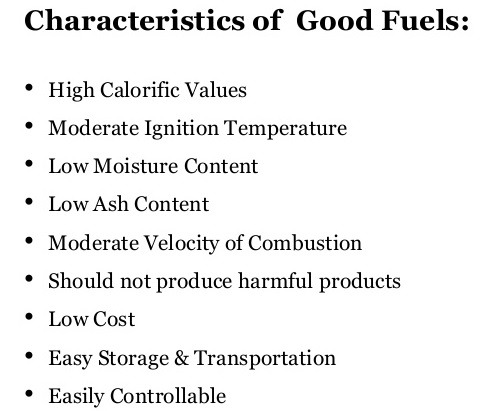What are the Different Types of Fuels and Their Characteristics
What are the Different Types of Fuels and Their Characteristics


Fuels
Most of the substances used for burning are fuels. Substances that produce heat and light energy on burning are called fuels. Some commonly used fuels are wood, coal, cow dung cakes, kerosene, LPG, petrol, and diesel. We use fuels for cooking, heating, in automobiles, and for the generation of electricity. Based on their physical state, fuels can be classified as solid, liquid, or gaseous.
Types of fuels
| Solid fuels | Liquid fuels | Gaseous fuels |
| Fuels that exist in solid state at room temperature are called solid fuels. Wood, charcoal, cow dung cakes, agricultural waste, and coal are examples of solid fuels. | Fuels that exist in liquid state at room temperature are called liquid fuels. Kerosene, petrol, diesel, and fuel oil are some examples of liquid fuels. | Fuels that exist in gaseous state at room temperature are called gaseous fuels. Petroleum gas, natural gas, and biogas are examples of gaseous fuels. |
Characteristics of Fuels
Not all combustible substances can be used as fuels for all applications. This is because although all fuels produce heat and light on burning, some produce more energy than others. Besides the amount of energy produced, the choice of fuel, whether for domestic or industrial use, also depends upon its cost, efficiency, availability, and the extent of pollution it causes. Two important characteristics of a fuel are its calorific value and efficiency.
Calorific value of a fuel is defined as the amount of heat produced in kilo joules when one gram of a fuel is completely burned. The unit for representing calorific value is kilo joule (kJ). Calorific value is expressed in kJ/g. In simple terms, the higher the calorific value of a fuel, the more heat it produces when burned. Thus, the higher the calorific value of a fuel, the better fuel it is. Calorific values of some fuels are given in Table.
| Fuel | Calorific value (kJ/g) |
| 1. Wood pellets | 17 |
| 2. Coal | 25-33 |
| 3. Charcoal | 35 |
| 4. Cow dung cakes | 7 |
| 5. Coke | 33 |
| 6. Kerosene | 48 |
| 7. Petrol | 47 |
| 8. Biogas | 35-40 |
| 9. LPG | 50 |
| 10. Methane | 55 |
| 11. Hydrogen | 150 |
When a fuel is burnt, some of the energy produced is given off as waste heat, which cannot be used for cooking or other purposes. This is what affects the efficiency of a fuel. Till date, no fuel-burning device is known to exhibit 100% efficiency.
The following are some of the important characteristics of an ideal fuel.
- It should have a high calorific value.
- Its ignition temperature should be low but well above the room temperature. If the ignition temperature is too low, the fuel will catch fire very easily (which could be dangerous) and if it is very high, the fuel has to be heated for a long time before it can catch fire.
- It should have a moderate rate of combustion and should release heat in a controlled manner.
- It should be fairly cheap and easily available. A fuel may have a very high calorific value but if it is expensive and not easily available, it cannot be used on a day-to-day basis.
- It should be safe to handle, store, and transport.
- It should not cause pollution on burning.
Let us discuss some fuels based on these characteristics.
Hydrogen as fuel: Hydrogen is considered the best fuel as it has the highest calorific value. Hence, it is considered the best fuel. However, as it is highly inflammable, there are difficulties associated with its transport, storage, and handling. It is, therefore, used as a fuel only where it is absolutely necessary (e.g., as rocket fuel).
Methane and LPG as fuels: Both methane and LPG have fairly high calorific values. They burn with a smokeless fire and, therefore, do not cause pollution. They are ideal for use as domestic fuels.
Petrol and diesel as fuels: Both petrol and diesel are mainly used in automobiles. Their main disadvantage is their limited availability. Another disadvantage is that their combustion releases harmful gases into the atmosphere.
The post What are the Different Types of Fuels and Their Characteristics appeared first on A Plus Topper.
from A Plus Topper
via Learning Made Simple 360
*Note that these contents are Autoblogged from A Plus Topper and cannot be edited.
Join the conversation